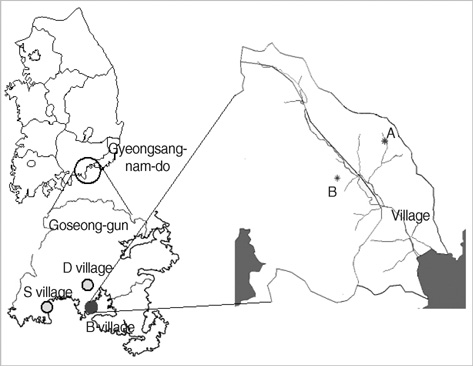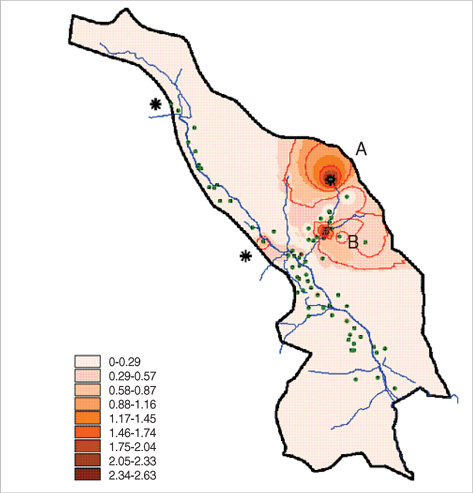J Korean Med Sci.
2008 Jun;23(3):452-458. 10.3346/jkms.2008.23.3.452.
Investigation on Health Effects of an Abandoned Metal Mine
- Affiliations
-
- 1Department of Social and Preventive Medicine, Sungkyunkwan University School of Medicine, Suwon, Korea.
- 2Department of Preventive Medicine, Dankook University College of Medicine, Cheonan, Korea. hojang@dku.edu
- 3Department of Environmental Health, Graduate School of Public Health, Seoul National University, Seoul, Korea.
- 4Department of Preventive Medicine, Ajou University School of Medicine, Suwon, Korea.
- 5National Institute of Environmental Research, Incheon, Korea.
- 6Masan Samsung Hospital, Sungkyunkwan University School of Medicine, Masan, Korea.
- 7Changwon Fatima Hospital, Changwon, Korea.
- 8Eulji University Hospital, Daejeon, Korea.
- 9Korean Institute of Science and Technology, Seoul, Korea.
- 10Catholic University of Daegu, Daegu, Korea.
- 11Department of Preventive Medicine, Seoul National University College of Medicine, Seoul, Korea.
- KMID: 1786884
- DOI: http://doi.org/10.3346/jkms.2008.23.3.452
Abstract
- To investigate potential health risks associated with exposure to metals from an abandoned metal mine, the authors studied people living near an abandoned mine (n=102) and control groups (n=149). Levels of cadmium, copper, arsenic, lead, and zinc were measured in the air, soil, drinking water, and agricultural products. To assess individual exposure, biomarkers of each metal in blood and urine were measured. beta2-microglobulin, alpha1-microglobulin, and N-acetyl-beta-glucosaminidase and bone mineral density were measured. Surface soil in the study area showed 2-10 times higher levels of metals compared to that of the control area. Metal concentrations in the groundwater and air did not show any notable differences between groups. Mean concentrations of cadmium and copper in rice and barley from the study area were significantly higher than those of the control area (p<0.05). Geometric means of blood and urine cadmium in the study area were 2.9 microgram/L and 1.5 microgram/g Cr, respectively, significantly higher than those in the control area (p<0.05). There were no differences in the levels of urinary markers of early kidney dysfunction and bone mineral density. The authors conclude that the residents near the abandoned mine were exposed to higher levels of metals through various routes.
MeSH Terms
Figure
Reference
-
1. Thornton I. Sources and pathways of arsenic in south-west England: health implications. exposure and health effect of arsenic. 1995. University of Missouri;93–103.2. Steinborn M, Breen J. Heavy metals in soil and vegetation at shallee mine, silvermines, co. Tipparery. biology and environment. proceedings of the royal Irish academy. 1999. 99B:37–42.3. Aslibekian O, Moles R. Environmental risk assessment of metals contaminated soils at silver mines abandoned mine site, co tipperary, Ireland. Environ Geochem Health. 2003. 25:247–266.4. Kim JY, Kim KW, Ahn JS, Ko I, Lee CH. Investigation and risk assessment modeling of As and other heavy metals contamination around five abandoned metal mines in Korea. Environ Geochem Health. 2005. 27:193–203.
Article5. Korean Minister of Environment. Available from: http://www.me.go.kr.6. Mayan ON, Gomes MJ, Henriques A, Silva S, Begonha A. Health survey among people living near an abandoned mine. A case study: Jales mine, Portugal. Environ Monit Assess. 2006. 123:31–40.
Article7. Park JD, Park CH, Choi BS, Kang EY, Hong YP, Chang IW, Chun BY, Yeh MH. A study on urinary cadmium concentration and renal indices of inhabitant in an abandoned mine area. J Prev Med Public Health. 1998. 31:424–439.8. Chung JH, Kang PS, Kim CY, Lee KS, Hwang TY, Kim GT, Park JS, Park SY, Kim DS, Lim OT, Sakong J. Blood Pb, urine Cd and health assessment of residents in the vicinity of abandoned mines in Gyeongsangbuk-do. Korean J Occup Environ Med. 2005. 17:225–237.
Article9. Nakdong River Basin Environmental Office. A close examination on the environmental pollution by abandoned mine. 2001.10. U.S Environmental Protection Agency. Available from: http://www.epa.gov/SW-846.11. Buchet JP, Lauwerys R, Roels H, Bernard A, Bruaux P, Claeys F, Ducoffre G, de Plaen P, Staessen J, Amery A, Lijnen P, Thijs L, Rondia D, Sartor F, Remy AS, Nick L. Renal effects of cadmium body burden of the general population. Lancet. 1990. 336:699–702.12. Staessen JA, Roels HA, Emelianov D, Kuznetsova T, Thijs L, Vangronsveld J, Fagard R. Environmental exposure to cadmium, forearm bone density, and risk of fractures: prospective population study. Public health and environmental exposure to cadmium (PheeCad) study group. Lancet. 1999. 353:1140–1144.13. World Health Organization (WHO). Cadmium. Environmental health criteria. 1992. Geneva: 134.14. Aoshima K. Epidemiology of renal tubular dysfunction in the inhabitants of a cadmium-polluted area in the Jinzu river basin in Toyama prefecture. Tohoku J Exp Med. 1987. 152:151–172.
Article15. Berglund M, Bjerre B, Vahter M. Investigation of lead and cadmium exposure in Smedjebacke. Karolinska Institue Report. 1994. Institute of Environmental Medicine.16. Passariello B, Giuliano V, Quaresima S, Barbaro M, Caroli S, Forte G, Carelli G, Iavicoli I. Evaluation of the environmental contamination at an abandoned mining site. Microchemical Journal. 2002. 73:245–250.
Article17. Lee SW, Lee BT, Kim JY, Kim KW, Lee JS. Human risk assessment for heavy metals and as contamination in the abandoned metal mine areas, Korea. Environ Monit Assess. 2006. 119:233–244.
Article18. Kim MJ, Ahn KH, Jung Y, Lee S, Lim BR. Arsenic, cadmium, chromium, copper, lead, and zinc contamination in mine tailings and nearby streams of three abandoned mines from Korea. Bull Environ Contam Toxico. 2003. 70:942–947.
Article
- Full Text Links
- Actions
-
Cited
- CITED
-
- Close
- Share
- Similar articles
-
- Blood and Urinary Cadmium Concentration of Residents around Abandoned Metal Mines in Busan and Gyeongsangnam-do
- The Concentration of Cadmium in Urine, and Its Role in Health-risk Assessment of Residents in the Vicinity of Abandoned Mines in Gyeongsangbuk-do, Korea
- Blood Cadmium Concentration of Residents Living near Abandoned Metal Mines in Korea
- Blood Pb, Urine Cd and Health Assessment of Residents in the Vicinity of Abandoned Mines in Gyeongsangbuk-do
- Association of cadmium with diabetes in middle-aged residents of abandoned metal mines: the first health effect surveillance for residents in abandoned metal mines



